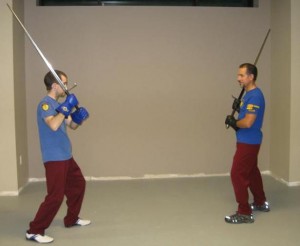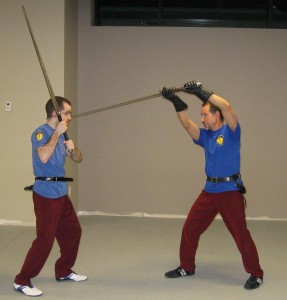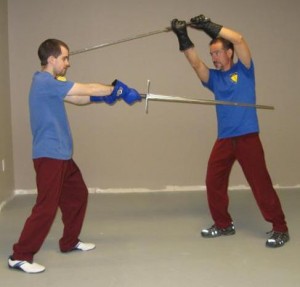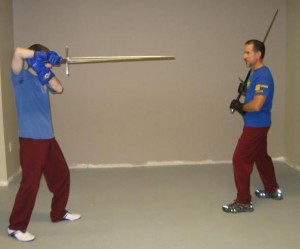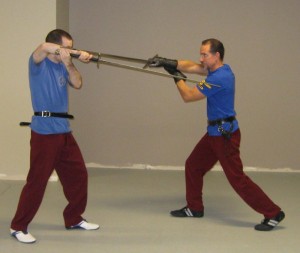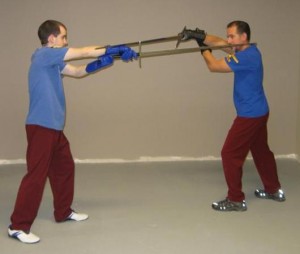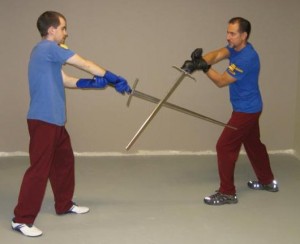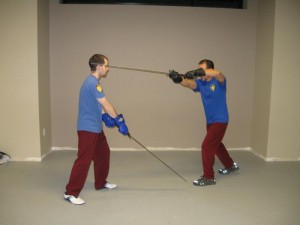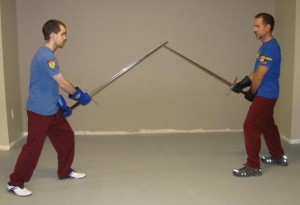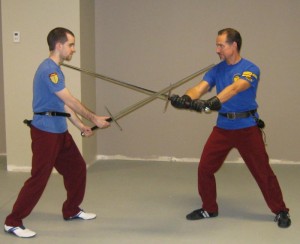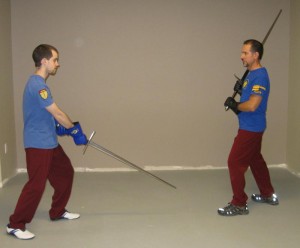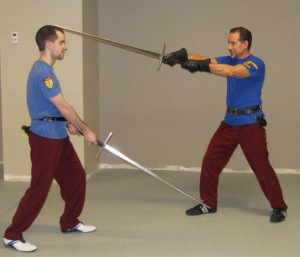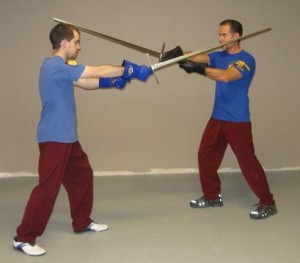Among the many salient points of Hanko Doebringer’s 1389 Fechbuch is the concept of Guard Breaking, which is a central feature of the longsword teachings of the great German Master, Johannes Liecthenauer. Doebringer tells us that the Master does not think highly of the guards, but wishes us to instead gain the first strike, the before. He says of this concept:
“But before all things, remember that you should not remain too long in one guard. Liechtenauer has a saying “He who is still, is dead, he who moves will live”. And from these guards comes the understanding that you should move in swordplay, and not wait in a guard and thus waste your chance.”
For each of the four basic guards (vom Tag, Ochs, Pflug & Olber) there is a master-cut (Meisterhau) that will break it, a concept also taught by later German Masters Sigmund Ringeck and Hans Talhoffer under the term Absetzen. Some of the breaks include attacks inherent in their action, while others must be followed up on with an after attack, which is consistent with Doebringer’s description of before and after according to the Master. The before is the first attack of the encounter, the after is the second attack … if you gain the before then you should also take the after, if you fail to get the before you must get the after. The guard-break combinations are listed below.
- Vom Tag is broken by Zwerchhau.
- Ochs is broken by Krumphau.
- Pflug is broken by Schielhau.
- Olber is broken by Scheitelhau.
In the picture examples we show the guards are always on the left and the Meisterhau on the right. More than one starting point is potentially possible for the Meisterhau, the pictures indicate only one option. Let the shortest route to the desired opening, the situation and your individual tactics guide you. However, unlike the pictures do not expect your opponent will just stand there and let you break his guard or counter his attack! Speed and intent are key to making this successful along with keeping your intent secret by not telegraphing your actions.
Defending against a guard-break can be tricky, after all it implies that either you waited too long in a guard and thus lost the before, or, that you lacked speed and intent when you began your attack and lost the after. Either way you will now find yourself using whatever is at your disposal to gain back the initiative in the fight (or you’ve had it) and this may be anything from a well-timed Kron, Winden, or Ringen. Doebringer tells us that if we are displaced to quickly leave his sword and strike at him, no matter how he does the displacement.
A note before you begin! Guard-breaking comes from the time when sword fighting was done in earnest, it was not meant for sport but for bodily harm. Therefore it is important that you conduct this training using proper protective gear and under the supervision of a qualified WMA instructor. Use control and discretion while practicing and be cognizant of the risks.
Vom Tag is Broken by Zwerchau:
Beginning in Vom Tag.
There are many possibilities for attack with vom Tag, with the main possibility of making upper opening attacks. Fastest attacks will be Zornhau and Scheitelhau.
The Before.
The After.
Zwerchhau is a horizontal attack using the false edge. Without telegraphing your intent to move forward, rotate the hand by the pommel around towards your head while pushing the hand by the cross guard forward and up. When you are done your pommel should be above and in front of your head. It is essential to keep the cross high and in front of you during this strike to provide a defense against your opponent’s speed in striking at you. The cross is also kept parallel to the ground to provide the extra possibility of catching his weak. Step slightly off-line when you step forward and don’t step too far. Strike with the tip across his head.
Zwerchhau can also be used in striking lower areas, but in all cases keep the cross as high as possible to protect yourself in keeping with the concept that every attack is a defense.
Ochs is Broken by Krumphau:
Beginning in Vom Tag.
The man on the left begins in Ochs with the likely attack being a thrust or slice to the upper openings. Krumphau is a forward, angled cut with either edge. In the following picture note the final position of the hands on the right and how far forward the tip goes. To get here you must drive the pommel underneath the top arm until your forearms cross and touch.
The Before.
For the man on the right the before is to Krump across the hands or forearms. If you step too far forward you may over-shoot your strike.
The After.
With the after you must bring your edge down on the target and you must be fast enough to stop the thrust before it is fully deployed. If Krumping against a Zornhau you must make your attack early and catch the hands or blade before it gets past the point that you can re-direct it.
Krump the blade to break the Master.
Doebringer tells us that if we want to weaken a master that we should Krump against his blade. Perform this with your flat on his blade to avoid edge damage to your sword. If you strike hard enough you may completely disarm your opponent with the Krump.
If you strike the blade instead of the hands then follow up immediately in the shortest distance to the closest opening as Doebringer repeatedly advises us in his Fechtbuch. Demonstrated here is a false edge strike to the side of the head like a Schielhau. This is done by uncrossing the arms out of the Krumphau.
Pflug is Broken by Schielhau:
Beginning in Pflug.
Both begin in Pflug, and while this is not required for the one on the right, it will serve this demonstration well enough. The attack is most likely to be a thrust. The movement involves pushing the hilt from right to left in order to pickup left’s weak on right’s strong. The false edge is turned a complete 180 degrees to the bottom as this happens and the hilt moves far enough to the left to completely displace the point away from your body. It helps to hold the sword somewhat loosely with the front hand, so that the sword will turn easily. A short step can also be taken.
Before and After look similar.
While not a strict Schielhau strike the false edge of the attackers blade will hit the defender. Keep your point from wavering as you slide up his blade and aim for the face or throat.
Alber is Broken by Scheitelhau:
Starting in Vom Tag.
Alber is not a guard of strength to await combat with a Master as the defender is using his weakest muscles to fight gravity in his actions. If the Scheitelhau is done with speed and intent victory is practically assured as there is almost no way for the man on the left to lift his blade before being struck.
The Before.
Scheitelhau is a true-edge cut that aims for the scalp or upper chest. Push the top hand sharply forward while pulling the pommel to the rear. A short step to get off-line is a good idea, either forwards or backwards as the situation dictates.
The After.
Conclusion:
Guard Breaking is a simple concept to learn and practice, and is one of the core skills handed down in longsword fighting from Master Liechtenauer. It reinforces the conceptsof not staying in a static guard, and that of always seizing the initiative to attack. Guard Breaking clearly demonstrates Doebringer’s simple statement “If it was not art, then the strong would always win”.
Further Reading:
- Cod.HS.3227a – Hanko Doebringer Fechtbuch, 1389, translated by David Lindholm and Friends, 2005
- Sigmund Ringeck’s Knightly Art of the Longsword, David Lindhold & Peter Svard, 2003
- Fight Earnestly, 1459 Thott Fechtbuch, Hans Talhoffer, translated by Jeffrey Hull, 2007
Photo Credits:
Nikolai Gloeckler & Vincent Moroz
